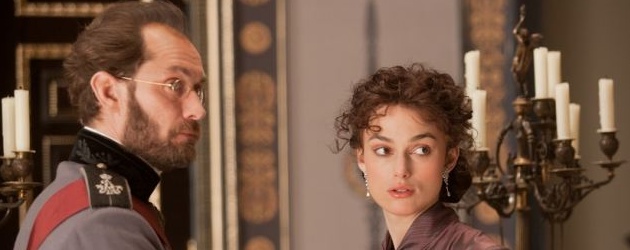
“All the world’s a stage, and all the men and women merely players.” It seems fitting to start off with a quote by Shakespeare, especially since that’s what it looks like when you watch Anna Karenina directed by Joe Wright. The film may be set in Russia during the revolution, but Wright has reduced the setting to two primary places. A practical outdoor farmland and a theatrical stage that represents the world that is set around the characters. While the film may be about love, passion, lust, tragedy and embrace, Wright’s vision really comes out in the film’s settings. Read the full review below.
The idea of having Anna Karenina primarily set in two areas can really restrict the movements of the characters but also gives them a chance to express themselves in ways they can’t if it was wide open. But the film isn’t completely set on a theatrical stage, Wright just wants you to think it is. There are times in the film where various members of the cast are shifting and moving various set pieces around to change the world that surrounds the characters.
But that is what is so exciting about Anna Karenina. The audience sees that there is a stage and that the characters’ lives are set on it, but when the area itself expands, we see a new world, but also recognize that it is still on the stage itself. However anyone who is in awe of Wright’s imagination and knack for using the framing device to its advantage might forget that there are actual characters to look at.
So like characters on a stage, the movements are very much like a dance, it is all very well choreographed. Don’t for one moment question why characters move the way they do because everything is done for a reason. From the start of the film we see and understand why Wright framed the film so that Russia resembles a stage. Sidi Larbi Cherkaoui made everything look like a dance, which seems fitting given where Wright wants us to think the film is set.
Those who are not familiar with Leo Tolstoy’s Russian classic Anna Karenina should know they are going to see a film about love, tragedy, passion, and lust. Keira Knightley plays as the beautiful aristocratic titular character who cheats on her high-class uptight military officer husband Alexi Karenin(Jude Law) with a very young and impressionable military officer Count Vronsky (Aaron Johnson). As Anna’s love with Vronsky grows deeper, Alexi’s suspicions begin to grow and it becomes theatrical melodrama. The film also has a subplot that mirror’s Anna’s story. In it we see Levin (Domhnall Gleeson), who is infatuated with Kitty (Alicia Vikander). With the help of Anna’s older brother Oblonsky (Matthew Macfadyen), Levin’s persistence for true love scours the film.
The only problem is that the look and feel of this film is so beautiful that you will probably start to lose interest in the characters. There are things at stake and the characters will go through some sort of tragedy, but each and every one of their movements are just so beautiful that the dialogue takes a backseat. We start to care less about what they are saying and grow more concerned with how they are moving.
Which can be a detriment to the film itself. In essence we are just watching one large dance. So no matter how powerful, sexually expressive, and raw these movements are, the interest in the dialogue portion of the film is nowhere to be found. Yet the expression in the characters’ movements tell the story. We understand the status of the characters and the extras and where they stand in the film just by looking at how they move. The beauty of reducing the setting of the film to two areas was really a novel idea, but in the end we are left wondering which world we are looking at, the real world, the stage, or the stage that is perceived as world by the film’s characters.
Anna Karenina opens in limited theaters on November 16 and then expands to more cities next week, and finally opens in wide release on November 30.